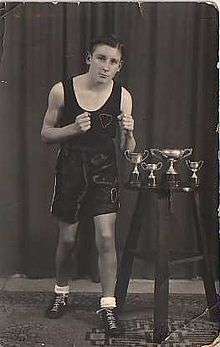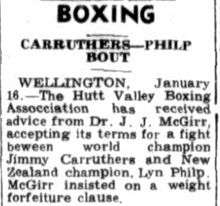Lyn Philp
Lyn Philp was a New Zealand professional boxer, and New Zealand's Bantamweight Champion from 1947 - 1954.
- Ranked fourth best bantamweight New Zealand all-time greats.[1]
| Lyn Philp | |
|---|---|
 | |
| Statistics | |
| Real name | Lynley V Philp |
| Weight(s) | Bantamweight |
| Nationality | |
| Born | 27 January 1924 Lower Hutt, New Zealand |
| Died | 17 July 1981 (aged 57) |
| Stance | Orthodox |
| Boxing record | |
| Total fights | 10 |
| Wins | 6 |
| Wins by KO | 2 |
| Losses | 4 |
| Draws | 0 |
| No contests | 0 |
With his punching power, speed and elusive style, Philp soon became the #1 contender for the bantamweight belt. In 1960 he was ranked third best bantamweight in New Zealand history.[2]
Biography
During World War II, Philp was drafted into the New Zealand Army, serving with distinction in the Middle East and Japan in World War II.[3]
Amateur career
In the spring of 1942, the United States First Marine Division sailed for Wellington, prior to opening a counteroffensive against the advancing Japanese forces. The marines were matched to fight local boxers on the preliminaries to the Strickland-Mullett heavyweight title fight. In the local team there appeared two Wellington fighters who were to turn professional after the war, Jack McCann and Lyn Philp. Both had wins over US Marines, and 15-year-old Bobby Goslin, drawn to meet P. Gonsalves, less than a minute later they were picking a semi-conscious Marine up off the deck! Goslin who would represent New Zealand at the 1948 Olympics. Philp, incidentally, fought Goslin three times, winning once and losing twice. Philp while serving with J Force[4] in Japan after the war, he would win a tournament in Kure,[5] beating an Australian in the final. [6] Kure is at the southern end of Japan’s main island Honshū. The allocated area of occupation included the Hiroshima Prefecture.
Professional career
| Wikimedia Commons has media related to Lyn Philp (Boxer). |
He started his pro-career as a bantamweight joining the training stable of the legendary Dick Dunn. His first professional fight was a win against Ronnie Hawes on 21 April 1947 at Wellington Town Hall.[7]
At Hastings New Zealand on 6 August 1947, and his second professional fight he met Tot Hoggarth the bantamweight champion in the first of three meetings between the pair, being defeated in round twelve. In his rematch with Tot Hoggarth, on 6 October 1947 at Petone New Zealand he won by KO, setting the stage for the final showdown and the battle for the belt.
The Philp-Hoggarth battle took place on 21 February 1948 at the Petone Recreation Ground New Zealand. For the third and final time they would meet to decide the champion. Hoggarth was stopped by knock-out, Philp winning the New Zealand bantamweight title and the belt. He retained the belt until his eventual retirement from the ring on 6 June 1954, when he vacated the title.
In 1954 he stepped up to featherweight fighting Johnny Hanks for the vacant featherweight title, losing by KO in round eight.
World Title Fight

He was matched for a world title bout against World Champion Jimmy Carruthers.[8] For reasons unclear the fight never went ahead.
Career record
| 6 Wins (2 knockouts, 4 decisions), 4 Losses (3 knockouts, 1 decision), 0 Draws | ||||||
| Result | Opponent | Type | Rd., Time | Date | Location | Notes |
|---|---|---|---|---|---|---|
| LOST | KO | 8 (15) | 14 June 1954 | For vacant New Zealand featherweight title, after title vacated by Tom Batty's retirement | ||
| LOST | PTS | 10 (10) | 1 June 1953 | |||
| Win | PTS | 10 (10) | 29 December 1949 | |||
| Win | PTS | 10 (10) | 3 December 1949 | |||
| LOST | KO | 4 (12) | 13 June 1949 | |||
| Win | PTS | 10 (10) | 24 December 1948 | |||
| Win | KO | 10 (15) | 21 February 1948 | For New Zealand bantamweight title. Philp retired 6 June 1954, vacating the title | ||
| Win | KO | 9 (10) | 6 October 1947 | |||
| LOST | KO | 12 (15) | 6 August 1947 | For New Zealand bantamweight title | ||
| Win | PTS | 10 (10) | 21 April 1947 | |||
Personal life
After retiring from the ring Lyn Philp opened a boxing gym where he became a trainer and coach.
References
- "Lyn Philp". Rankings BoxRec. Archived from the original on 9 October 2012. Retrieved 25 May 2009.
- O'BRIEN, Brian F. - KIWIS WITH GLOVES ON. Wellington: A.H. & A.W. Reed, 1960.
- "Lyn Philp". J Force. Archived from the original on 13 May 2010. Retrieved 27 May 2009.
- "The Occupiers". Penguin Publishers. Archived from the original on 1 February 2016. Retrieved 27 August 2015.
- "Hiroshima". City of Kure. Archived from the original on 22 June 2009.
- One Hundred Years of Boxing In New Zealand by Klein.R.B.
- "Lyn Philp". BoxRec. Archived from the original on 26 September 2012. Retrieved 11 January 2008.
- "The Mercury Newspaper". Thursday, January 15, 1953.